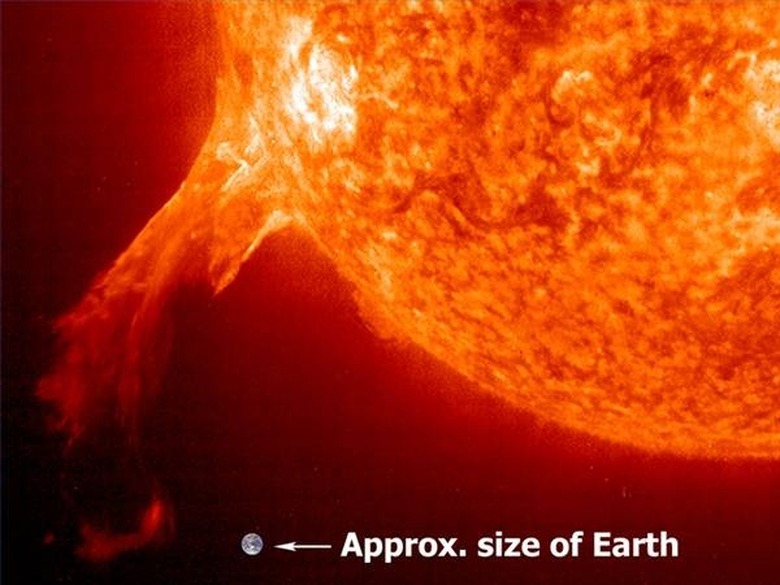How Do Prominences Affect The Earth?
A prominence is an extension outward from the Sun's surface that's visible with appropriate astronomical equipment. Prominences are typically tens of thousands of miles long, though one observed in 1997 extended over 200,000 miles, about 28 times the diameter of the earth. It only takes about a day for a prominence to form, but some can last for as long as several months. Though prominences mostly consist of charged particles and are not solid, their mass is typically around 100 billion tons. Prominences are associated with the release of high energy particles, known as a solar flare. If a prominence breaks apart, it produces a coronal mass ejection.
The solar flare aspect of a prominence has the most common effect on the earth. Normally, the magnetic field surrounding earth deflects harmful solar radiation. If not, life would be impossible. The X-ray and UV radiation emitted in a solar flare, however, can penetrate the earth's natural defenses. Solar flares, also called solar storms, release a wave of high-energy, positively charged protons that can pass through the human body. Once detected, they take minutes to a few hours to reach the planet. Their most common effect is on radar, long-range radio and communications satellites.
A massive solar flare hobbled a Japanese satellite in 2003. The barrage of protons created excessive "noise" that scrambled the satellite's sensors. Powerful solar flares, or solar clouds, can have a similar effect on ground communications and even disrupt transmission in electrical power grids. In 2005, one of the largest solar flares on record created a complete blackout of high-frequency communications on the side of Earth facing the sun at the time, which included the entire U.S. GPS and satellite TV reception can be also be impacted by such activity from the sun.
The most extreme aspect of a solar prominence is the coronal mass ejection (CME). In addition to damaging communications, the intensity of a CME can drag on satellites and threaten their orbits. A particularly bad CME could pose radiation risks on earth, but they are certainly a major risk to astronauts. Because of the speed with which CMEs and solar flares propagate through space, quick access to proper protection will have to be a part of any manned missions to Mars or the Moon. In 2005, U.S. astronauts were forced to take shelter in the Russian module of the International Space Station, which was better reinforced to withstand a solar storm.
Radiation from the sun does have a silver lining, however. The Northern Lights, aurora borealis, are the result of changes in the earth's magnetosphere caused by the solar wind. The effects can be especially pronounced and beautiful to the terrestrial observer during a solar flare or prominence.
Cite This Article
MLA
Nicholson, Joseph. "How Do Prominences Affect The Earth?" sciencing.com, https://www.sciencing.com/prominences-affect-earth-4566919/. 24 April 2017.
APA
Nicholson, Joseph. (2017, April 24). How Do Prominences Affect The Earth?. sciencing.com. Retrieved from https://www.sciencing.com/prominences-affect-earth-4566919/
Chicago
Nicholson, Joseph. How Do Prominences Affect The Earth? last modified March 24, 2022. https://www.sciencing.com/prominences-affect-earth-4566919/





